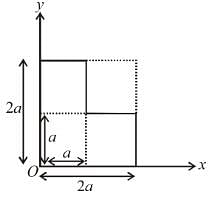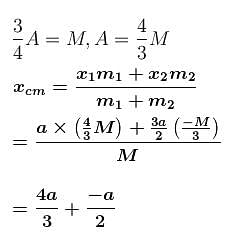All Exams >
Physics >
Mechanics & General Properties of Matter >
All Questions
All questions of Centre of Mass & Moment of Inertia for Physics Exam
A ball of mass 50gm is dropped from a height h = 10m. It rebounds losing 75 percent of its kinetic energy. If it remains in contact with the ground for Δt = 0.01 sec., the impulse of the impact force (in N-s) is : (take g =10 m/s2)
Correct answer is '1.05'. Can you explain this answer?
A ball of mass 50gm is dropped from a height h = 10m. It rebounds losing 75 percent of its kinetic energy. If it remains in contact with the ground for Δt = 0.01 sec., the impulse of the impact force (in N-s) is : (take g =10 m/s2)
|
|
Vedika Singh answered |
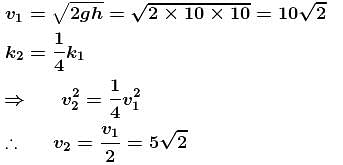

The correct answer is: 1.05
| 1 Crore+ students have signed up on EduRev. Have you? Download the App |
The block of mass M moving on the frictionless horizontal surface collides with the spring of spring constant k and compresses it by length L. The maximum momentum of the block after collision is :- a)

- b)0
- c)

- d)

Correct answer is option 'C'. Can you explain this answer?
The block of mass M moving on the frictionless horizontal surface collides with the spring of spring constant k and compresses it by length L. The maximum momentum of the block after collision is :
a)

b)
0
c)

d)

|
|
Vedika Singh answered |
According to conservation of energy

MkL2 = p2 (p = mu)

The correct answer is: 

A particle of mass m moving with velocity u1 collides elastically with another particle of same mass moving with velocity u2 in the same direction. After collision their speeds are v1 and v2 respectively then
(A) u1 + v1 = v2 + u2
(B) u1 – v1 = v2 + u2- a)Equation B is correct but not A
- b)Equation A is correct but not B
- c)Both the equations A and B are incorrect
- d)Both the equations A and B are correct
Correct answer is option 'B'. Can you explain this answer?
A particle of mass m moving with velocity u1 collides elastically with another particle of same mass moving with velocity u2 in the same direction. After collision their speeds are v1 and v2 respectively then
(A) u1 + v1 = v2 + u2
(B) u1 – v1 = v2 + u2
(A) u1 + v1 = v2 + u2
(B) u1 – v1 = v2 + u2
a)
Equation B is correct but not A
b)
Equation A is correct but not B
c)
Both the equations A and B are incorrect
d)
Both the equations A and B are correct
|
|
Jayant Mishra answered |
Equation A is correct but not B
 (For elastic collision e = 1)
(For elastic collision e = 1)
⇒ 1(u2 – u1) = –(v2 – v1)
⇒ u2 + v2 = u1 + v1
The correct answer is: Equation A is correct but not B
 (For elastic collision e = 1)
(For elastic collision e = 1)⇒ 1(u2 – u1) = –(v2 – v1)
⇒ u2 + v2 = u1 + v1
The correct answer is: Equation A is correct but not B
A plate of mass M is moved with constant velocity v against dust particles moving with velocity u in opposite direction as shown. The density of the dust is ρ and plate area is A. Find the force F required to keep the plate moving uniformly is Aρ(u + v)N, then N is :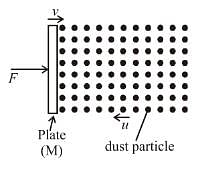
Correct answer is '2'. Can you explain this answer?
A plate of mass M is moved with constant velocity v against dust particles moving with velocity u in opposite direction as shown. The density of the dust is ρ and plate area is A. Find the force F required to keep the plate moving uniformly is Aρ(u + v)N, then N is :

|
|
Jayant Mishra answered |
Force F on plate = force exerted by dust particles
= force on dust particles by the plate
= rate of change of momentum of dust particles
= mass of dust particles striking the plate per unit time × change in velocity of dust particles
= force on dust particles by the plate
= rate of change of momentum of dust particles
= mass of dust particles striking the plate per unit time × change in velocity of dust particles

The correct answer is: 2
Two particles of mass 1kg and 0.5kg are moving in the same direction with speed of 2 m/s and 6 m/s respectively on a smooth horizontal surface. The speed of centre of mass of the system in m/s is :
Correct answer is '3.333'. Can you explain this answer?
Two particles of mass 1kg and 0.5kg are moving in the same direction with speed of 2 m/s and 6 m/s respectively on a smooth horizontal surface. The speed of centre of mass of the system in m/s is :
|
|
Vedika Singh answered |

The correct answer is: 3.333
The centre of the mass of the shaded portion of the disc is : (The mass is uniformly distributed in the shaded portion) :
- a)R/12 to the right of A
- b)R/12 to the left of A
- c)R/20 to the right of A
- d)R/20 to the left of A
Correct answer is option 'D'. Can you explain this answer?
The centre of the mass of the shaded portion of the disc is : (The mass is uniformly distributed in the shaded portion) :

a)
R/12 to the right of A
b)
R/12 to the left of A
c)
R/20 to the right of A
d)
R/20 to the left of A
|
|
Vedika Singh answered |

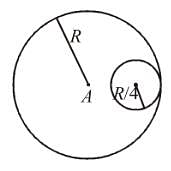

The correct answer is: R/20 to the left of A
A ball of mass m moving with a velocity v hits a massive wall of mass M (M >> m) moving towards the ball with a velocity u. An elastic impact lasts for a time Δt. Which of the following are correct.- a)The average elastic force acting on the ball is

- b)The kinetic energy of the ball remains the same after the collision.
- c)The kinetic energy of the ball increase by 2mu(u+v)
- d)The average elastic force acting on the ball is

Correct answer is option 'C,D'. Can you explain this answer?
A ball of mass m moving with a velocity v hits a massive wall of mass M (M >> m) moving towards the ball with a velocity u. An elastic impact lasts for a time Δt. Which of the following are correct.
a)
The average elastic force acting on the ball is 

b)
The kinetic energy of the ball remains the same after the collision.
c)
The kinetic energy of the ball increase by 2mu(u+v)
d)
The average elastic force acting on the ball is 


|
Pie Academy answered |
In an elastic collision
vsep = vapp
vsep = vapp


change in momentum of ball is 


= 2m(u + v)

The correct answers are: The average elastic force acting on the ball is  The kinetic energy of the ball increase by 2mu(u+v)
The kinetic energy of the ball increase by 2mu(u+v)
 The kinetic energy of the ball increase by 2mu(u+v)
The kinetic energy of the ball increase by 2mu(u+v)A balloon having mass m is filled with gas and is held in hands of a boy. Then suddenly it get released and gas start coming out of it with a constant rate. The velocities of the ejected gases is also constant 2m/s with respect to the balloon. Find out the velocity of the balloon when the mass of gas is reduced to half. [Effect of atmosphere and gravity is neglected]
Correct answer is '1.386'. Can you explain this answer?
A balloon having mass m is filled with gas and is held in hands of a boy. Then suddenly it get released and gas start coming out of it with a constant rate. The velocities of the ejected gases is also constant 2m/s with respect to the balloon. Find out the velocity of the balloon when the mass of gas is reduced to half. [Effect of atmosphere and gravity is neglected]
|
|
Vedika Singh answered |
Neglecting gravity

u = ejection velocity w.r.t. balloon
m0 = initial mass
m1 = mass at any time t.

The correct answer is: 1.386
AB is and L shaped object fixed on a horizontal smooth table. A ball strikes if at A, gets deflected and restrikes it at B. If the velocity vector before collision is  and coefficient of restitution of each collision is ‘e’, then the velocity of ball after its second collision at B is :
and coefficient of restitution of each collision is ‘e’, then the velocity of ball after its second collision at B is :
- a)

- b)

- c)

- d)data insufficient
Correct answer is option 'A'. Can you explain this answer?
AB is and L shaped object fixed on a horizontal smooth table. A ball strikes if at A, gets deflected and restrikes it at B. If the velocity vector before collision is  and coefficient of restitution of each collision is ‘e’, then the velocity of ball after its second collision at B is :
and coefficient of restitution of each collision is ‘e’, then the velocity of ball after its second collision at B is :
 and coefficient of restitution of each collision is ‘e’, then the velocity of ball after its second collision at B is :
and coefficient of restitution of each collision is ‘e’, then the velocity of ball after its second collision at B is :
a)

b)

c)

d)
data insufficient

|
Pie Academy answered |

During 1st collision perpendicular component of  becomes e times, while IInd component v|| remains unchanged and similarly for second collision. The end result is that both v|| and
becomes e times, while IInd component v|| remains unchanged and similarly for second collision. The end result is that both v|| and  becomes e times their initial value and hence
becomes e times their initial value and hence  (the (–) sign indicates the reversal of direction).
(the (–) sign indicates the reversal of direction).
 becomes e times, while IInd component v|| remains unchanged and similarly for second collision. The end result is that both v|| and
becomes e times, while IInd component v|| remains unchanged and similarly for second collision. The end result is that both v|| and  becomes e times their initial value and hence
becomes e times their initial value and hence  (the (–) sign indicates the reversal of direction).
(the (–) sign indicates the reversal of direction).The correct answer is: 

In the figure shown a small block B of mass m is released from the top of a smooth movable wedge A of the same mass m. The height of wedge A shown in figure is h = 100cm. B ascends another movable smooth wedge C of the same mass. Neglecting friction any where find the maximum height (in cm) attained by block B on wedge C.
Correct answer is '25'. Can you explain this answer?
In the figure shown a small block B of mass m is released from the top of a smooth movable wedge A of the same mass m. The height of wedge A shown in figure is h = 100cm. B ascends another movable smooth wedge C of the same mass. Neglecting friction any where find the maximum height (in cm) attained by block B on wedge C.

|
|
Vedika Singh answered |

Let u and v be speed of wedge A and block B at just after the block B gets off the wedge A. Applying conservation of momentum in horizontal direction, we get.
mu = mv ...(1)
Applying conservation of energy between initial and final state as shown in figure (1), we get

solving (1) and (2) we get
 ...(3)
...(3)At the instant block B reaches maximum height h' on the wedge C(figure 2), the speed of block B and wedge C are v'.
Applying conservation of momentum in horizontal direction, we get


Applying conservation of energy between initial and final state

Solving equations (3), (4) and (5) we get

The correct answer is: 25
Particle A moves with speed 10 m/s in a frictionless circular fixed horizontal pipe of radius 5 m and strikes with B of double mass that of A. Coefficient of restitution is 1/2 and particle A starts its journey at t = 0. The time at which second collision occurs is given by nπ sec. Find the value of n.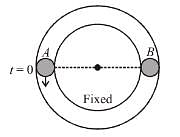
Correct answer is '2.5'. Can you explain this answer?
Particle A moves with speed 10 m/s in a frictionless circular fixed horizontal pipe of radius 5 m and strikes with B of double mass that of A. Coefficient of restitution is 1/2 and particle A starts its journey at t = 0. The time at which second collision occurs is given by nπ sec. Find the value of n.


|
Pie Academy answered |
For first collision v = 10 m/s, 

velocity of separation = e velocity of approach

v2 – v1 = 5m/s
for second collision


The correct answer is: 2.5
A canon shell moving along a straight line burst into two parts. Just after the burst one part moves with momentum 20 Ns making an angle 30° with the original line of motion. The minimum momentum of the other parts of shell just after the burst is :- a)0 Ns
- b)5 Ns
- c)17.32 Ns
- d)10 Ns
Correct answer is option 'D'. Can you explain this answer?
A canon shell moving along a straight line burst into two parts. Just after the burst one part moves with momentum 20 Ns making an angle 30° with the original line of motion. The minimum momentum of the other parts of shell just after the burst is :
a)
0 Ns
b)
5 Ns
c)
17.32 Ns
d)
10 Ns
|
|
Vedika Singh answered |
As shown in figure the component of momentum of one shell along initial direction and perpendicular to initial direction are  and P1y=10 Ns.
and P1y=10 Ns.
 and P1y=10 Ns.
and P1y=10 Ns.
For momentum of the system to be zero in y-direction P2y must be 10 Ns. 2nd part of shell may or not have momentum in x-direction.
∴ P2min = 10 Ns.
The correct answer is: 10 Ns
∴ P2min = 10 Ns.
The correct answer is: 10 Ns
In given figure, the small block of mass 2m is released from rest when the string is in horizontal position, Displacement of the ring when string makes an angle θ = 37° with the vertical will be :
Displacement of the ring when string makes an angle θ = 37° with the vertical will be :- a)

- b)

- c)

- d)None of these
Correct answer is option 'A'. Can you explain this answer?
In given figure, the small block of mass 2m is released from rest when the string is in horizontal position,

Displacement of the ring when string makes an angle θ = 37° with the vertical will be :
a)

b)

c)

d)
None of these
|
|
Jayant Mishra answered |
Taking 'O' as the origin;


A ball of mass m strikes the fixed inclined plane after falling through a height h. If it rebounds elastically, the impulse on the ball is :
- a)

- b)

- c)

- d)

Correct answer is option 'D'. Can you explain this answer?
A ball of mass m strikes the fixed inclined plane after falling through a height h. If it rebounds elastically, the impulse on the ball is :

a)

b)

c)

d)

|
|
Vedika Singh answered |
Here e = 1
If ball rebounded elastically
vLOI = uLOI
If ball rebounded elastically
vLOI = uLOI

∴ Along line of impact momentum conservation

Along line of impact

The correct answer is: 

For a two-body system in absence of external forces, the kinetic energy as measured from ground frame is K0 and from centre of mass frame is Kcm. Pick up the correct statement.- a)The kinetic energy as measured from centre of mass frame is least
- b)The system always retains at least Kcm amount of kinetic energy as measured from ground frame irrespective of any kind of internal changes in the system.
- c)The system always retains at least K0–Kcm amount of kinetic energy as measured from ground frame irrespective of any kind of internal change in the system.
- d)Only the portion of energy Kcm can be transformed from one form to another due to internal changes in the system.
Correct answer is option 'A,C,D'. Can you explain this answer?
For a two-body system in absence of external forces, the kinetic energy as measured from ground frame is K0 and from centre of mass frame is Kcm. Pick up the correct statement.
a)
The kinetic energy as measured from centre of mass frame is least
b)
The system always retains at least Kcm amount of kinetic energy as measured from ground frame irrespective of any kind of internal changes in the system.
c)
The system always retains at least K0–Kcm amount of kinetic energy as measured from ground frame irrespective of any kind of internal change in the system.
d)
Only the portion of energy Kcm can be transformed from one form to another due to internal changes in the system.
|
|
Vedika Singh answered |
It can be shown that

where M is the total mass of the system and Vcm is velocity of centre of mass with respect to ground.
Due to internal changes Kcm can change but Vcm will remain same. Hence only Kcm portion of kinetic energy can be transformed to some other from of energy.
The correct answers are: The kinetic energy as measured from centre of mass frame is least, Only the portion of energy Kcm can be transformed from one form to another due to internal changes in the system., The system always retains at least K0–Kcm amount of kinetic energy as measured from ground frame irrespective of any kind of internal change in the system.
The correct answers are: The kinetic energy as measured from centre of mass frame is least, Only the portion of energy Kcm can be transformed from one form to another due to internal changes in the system., The system always retains at least K0–Kcm amount of kinetic energy as measured from ground frame irrespective of any kind of internal change in the system.
On a smooth carom board, a coin moving in negative y-direction with a speed of 3m/s is being hit at the point (4,6) by a striker moving along negative x-axis. The line joining centres of the coin and the striker just before the collision is parallel to x-axis. After collision the coin goes into the hole located at the origin. Masses of the striker and the coin are equal. Considering the collision to be elastic, the initial and final speeds of the striker in m/s will be:
- a)(1.2, 0)
- b)(2, 0)
- c)(3, 0)
- d)None of these
Correct answer is option 'B'. Can you explain this answer?
On a smooth carom board, a coin moving in negative y-direction with a speed of 3m/s is being hit at the point (4,6) by a striker moving along negative x-axis. The line joining centres of the coin and the striker just before the collision is parallel to x-axis. After collision the coin goes into the hole located at the origin. Masses of the striker and the coin are equal. Considering the collision to be elastic, the initial and final speeds of the striker in m/s will be:

a)
(1.2, 0)
b)
(2, 0)
c)
(3, 0)
d)
None of these
|
|
Jayant Mishra answered |
The line of impact for duration of collision is parallel to x-axis.
The situation of striker and coin just before the collision is given as
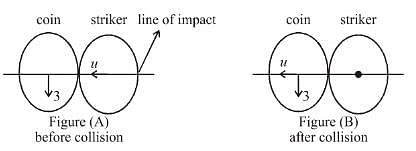
Because masses of coin and striker are same, their components of velocities along line of impact shall exchange. Hence the striker comes to rest and the x-y component of velocities of coin are u and 3m/s as shown in figure.

For coin to enter hole,
its velocity must be along PO

or u = 2m/s
The correct answer is: (2, 0)
A ball collides with an inclined plane of inclination θ after falling through a distance h. If it moves horizontally just after the impact, the coefficient of restitution is, when θ = 30:
Correct answer is '0.333'. Can you explain this answer?
A ball collides with an inclined plane of inclination θ after falling through a distance h. If it moves horizontally just after the impact, the coefficient of restitution is, when θ = 30:

|
|
Vedika Singh answered |

where  are velocities components of wedge and ball along the impulsive force after collision and
are velocities components of wedge and ball along the impulsive force after collision and  are velocities components of wedge and ball along the impulsive force before collision
are velocities components of wedge and ball along the impulsive force before collision
Wedge is at rest so,
 are velocities components of wedge and ball along the impulsive force after collision and
are velocities components of wedge and ball along the impulsive force after collision and  are velocities components of wedge and ball along the impulsive force before collision
are velocities components of wedge and ball along the impulsive force before collision Wedge is at rest so,



conserving the linear momentum in x-direction

On dividing equation (2) by (1)

The correct answer is: 0.333
A block of mass 0.50 kg is moving with a speed of 2.00 ms–1 on a smooth surface. It strikes another mass of 1.00 kg and then they move together as a single body. The energy loss (in Joule) during the collision is :
Correct answer is '0.67'. Can you explain this answer?
A block of mass 0.50 kg is moving with a speed of 2.00 ms–1 on a smooth surface. It strikes another mass of 1.00 kg and then they move together as a single body. The energy loss (in Joule) during the collision is :
|
|
Vedika Singh answered |
pi = pf (momentum conservation)

The correct answer is: 0.67
A gun is firing 20 balls per seconds of mass 20 gm each on the smooth horizontal table surface ABCD. If the collision is perfectly elastic and balls are striking at the centre of table with a speed 5 m/sec at an angle of 60° with the vertical just before collision, then force exerted by one of the leg on ground is (assume total weight of the table is 0.2 kg and g = 10 m/s2) :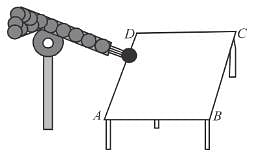
- a)0.75 N
- b)0.25 N
- c)0.5 N
- d)1 N
Correct answer is option 'D'. Can you explain this answer?
A gun is firing 20 balls per seconds of mass 20 gm each on the smooth horizontal table surface ABCD. If the collision is perfectly elastic and balls are striking at the centre of table with a speed 5 m/sec at an angle of 60° with the vertical just before collision, then force exerted by one of the leg on ground is (assume total weight of the table is 0.2 kg and g = 10 m/s2) :

a)
0.75 N
b)
0.25 N
c)
0.5 N
d)
1 N
|
|
Vedika Singh answered |
Force on table due to collision of balls :

Net force one leg 

The correct answer is: 1 N
A shell of mass 100 kg is fired horizontally from a canon with a mass of 5 × 103kg. The kinetic energy of the shell at the end of the barrel is 7.5 × 106 J. The kinetic energy imparted to the cannon by the recoil is  Find the value of α:
Find the value of α:
Correct answer is '1.5'. Can you explain this answer?
A shell of mass 100 kg is fired horizontally from a canon with a mass of 5 × 103kg. The kinetic energy of the shell at the end of the barrel is 7.5 × 106 J. The kinetic energy imparted to the cannon by the recoil is  Find the value of α:
Find the value of α:
 Find the value of α:
Find the value of α:|
|
Vedika Singh answered |
m = 100 kg
M = 5×103 kg
Initially system is at rest
M = 5×103 kg
Initially system is at rest
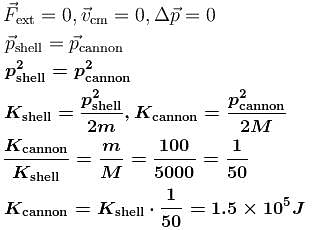
The correct answer is: 1.5
A smooth ball A moving with velocity v collides with another smooth identical ball at rest. After collision both the balls move with same speed with angle between their velocities 60°. No external force acts on the system of balls. The speed of each ball after collision is :
- a)v/3
- b)v/2
- c)v/√3
- d)2v/√3
Correct answer is option 'C'. Can you explain this answer?
A smooth ball A moving with velocity v collides with another smooth identical ball at rest. After collision both the balls move with same speed with angle between their velocities 60°. No external force acts on the system of balls. The speed of each ball after collision is :

a)
v/3
b)
v/2
c)
v/√3
d)
2v/√3
|
|
Vedika Singh answered |
From conservation of momentum

A bullet of mass m = 50gm strikes (Δt ≈ 0) a sand bag of mass M = 5 kg hanging from a fixed point with a horizontal velocity  If bullet sticks to the sand bag then the ratio of final and initial kinetic energy of the bullet is 10-α. Find the value of α:
If bullet sticks to the sand bag then the ratio of final and initial kinetic energy of the bullet is 10-α. Find the value of α:
Correct answer is '4'. Can you explain this answer?
A bullet of mass m = 50gm strikes (Δt ≈ 0) a sand bag of mass M = 5 kg hanging from a fixed point with a horizontal velocity  If bullet sticks to the sand bag then the ratio of final and initial kinetic energy of the bullet is 10-α. Find the value of α:
If bullet sticks to the sand bag then the ratio of final and initial kinetic energy of the bullet is 10-α. Find the value of α:
 If bullet sticks to the sand bag then the ratio of final and initial kinetic energy of the bullet is 10-α. Find the value of α:
If bullet sticks to the sand bag then the ratio of final and initial kinetic energy of the bullet is 10-α. Find the value of α:|
|
Vedika Singh answered |

The correct answer is: 4
A force time graph for a linear motion is shown in figure where the segments are circular. The linear momentum gained between 0 to 8 second is :
Correct answer is '0'. Can you explain this answer?
A force time graph for a linear motion is shown in figure where the segments are circular. The linear momentum gained between 0 to 8 second is :

|
|
Jayant Mishra answered |
Change in momentum = area F-t graph = 0
The correct answer is: 0
The correct answer is: 0
Each of the block shown in figure has mass 1 kg. The near block moves with a speed of 2 m/s towards the front block kept at rest. The spring attached to the front block is light and has a spring constant 50 N/m. Find the maximum compression of the spring. (in cm) :
Correct answer is '20'. Can you explain this answer?
Each of the block shown in figure has mass 1 kg. The near block moves with a speed of 2 m/s towards the front block kept at rest. The spring attached to the front block is light and has a spring constant 50 N/m. Find the maximum compression of the spring. (in cm) :

|
|
Vedika Singh answered |
Maximum compression will take place when the blocks move with equal velocity. As no net external horizontal force acts on the system of the two blocks, the total linear momentum will remain constant. If v is the common speed at maximum compression, we have,
(1 kg) (2m/s) = (1kg)v + (1kg)v
or v = 1m/s
Initial kinetic energy 

Final kinetic energy =


or x = 0.2m
The correct answer is: 20
Assuming potential energy U at ground level to be zero.
 All objects are made up of same material
All objects are made up of same material
UP = Potential energy of solid sphere
UQ = Potential energy of solid cube
UR = Potential energy of solid cone
US = Potential energy of solid cylinder
- a)UP < UQ
- b)US > UP
- c)UQ >US
- d)US > UR
Correct answer is option 'B,C'. Can you explain this answer?
Assuming potential energy U at ground level to be zero.

All objects are made up of same material
UP = Potential energy of solid sphere
UQ = Potential energy of solid cube
UR = Potential energy of solid cone
US = Potential energy of solid cylinder
UP = Potential energy of solid sphere
UQ = Potential energy of solid cube
UR = Potential energy of solid cone
US = Potential energy of solid cylinder
a)
UP < UQ
b)
US > UP
c)
UQ >US
d)
US > UR
|
|
Jayant Mishra answered |

centre of mass of cone is on smallest height.
The correct answers are: US > UP, UQ >US, US > UR
The diagram shows the velocity-time graph for two masses R and S that collided elastically. Which of the following statement is true?
- a)The mass of R was less than mass of S.
- b)The velocities of R and S were equal at the mid time of the collision
- c)R and S moved in the same direction after the collision
- d)The mass of R was greater than mass of S
Correct answer is option 'B,C,D'. Can you explain this answer?
The diagram shows the velocity-time graph for two masses R and S that collided elastically. Which of the following statement is true?

a)
The mass of R was less than mass of S.
b)
The velocities of R and S were equal at the mid time of the collision
c)
R and S moved in the same direction after the collision
d)
The mass of R was greater than mass of S
|
|
Vedika Singh answered |

(i) Since, both have positive final velocities, hence, both moved in the same direction after collision.
(ii) at t = 2 sec. both had equal velocities.
(iii) by conservation of linear momentum, we can say that mass of R was greater than mass of S.
The correct answers are: R and S moved in the same direction after the collision, The velocities of R and S were equal at the mid time of the collision, The mass of R was greater than mass of S
Block A is hanging from a vertical spring and it at rest. Block B strikes the block A with velocity v and sticks to it. The the value of v in m/s for which the spring just attains natural length is :
Correct answer is '6'. Can you explain this answer?
Block A is hanging from a vertical spring and it at rest. Block B strikes the block A with velocity v and sticks to it. The the value of v in m/s for which the spring just attains natural length is :

|
|
Vedika Singh answered |
The initial extension in spring is 
Just after collision of B with A the speed of combined mass is v/2.

Just after collision of B with A the speed of combined mass is v/2.
For the spring to just attain natural length of combined mass must rise up by  (see figure.) and comes to rest.
(see figure.) and comes to rest.
 (see figure.) and comes to rest.
(see figure.) and comes to rest.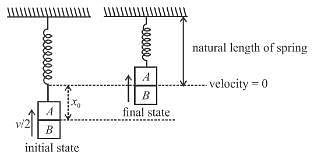
Applying conservation of energy between initial and final states

Alternate solution by SHM

The correct answer is: 6
When a block is placed on a wedge as shown in the figure, the block starts sliding down and the wedge also start sliding on ground. All surfaces are rough. The centre of mass of (Wedge + block) system will move :
- a)rightward and downward
- b)only downward
- c)leftward and downward
- d)leftward and upwards
Correct answer is option 'A'. Can you explain this answer?
When a block is placed on a wedge as shown in the figure, the block starts sliding down and the wedge also start sliding on ground. All surfaces are rough. The centre of mass of (Wedge + block) system will move :

a)
rightward and downward
b)
only downward
c)
leftward and downward
d)
leftward and upwards
|
|
Jayant Mishra answered |
Friction force between wedge and block is internal i.e. will not change motion of centre of mass. Friction force on the wedge by ground is external and causes centre of mass to move towards right. Gravitational force (mg) on block brings it downward hence centre of mass comes down.
The correct answer is: rightward and downward
A particle moving on a smooth horizontal surface strikes a stationary wall. The angle of strikes is equal to the angle of rebound and is equal to 37° and the coefficient of restitution with wall is e = 1/5. Find the friction coefficient between wall and the particle in the form X/10. What is the value of X.
Correct answer is '5'. Can you explain this answer?
A particle moving on a smooth horizontal surface strikes a stationary wall. The angle of strikes is equal to the angle of rebound and is equal to 37° and the coefficient of restitution with wall is e = 1/5. Find the friction coefficient between wall and the particle in the form X/10. What is the value of X.

|
|
Jayant Mishra answered |
Since e = 1/5
∴ Final normal component of velocity 
As the angle of rebound is equal to the angle before impact.

As the angle of rebound is equal to the angle before impact.
Therefore, both normal and tangential components of velocities must change by the same factor,
∴ Tangential velocity after impact becomes
Let the time of impact be Δt.
∴ Tangential velocity after impact becomes

Let the time of impact be Δt.

where N is the normal force imparted on the ball by the wall.


The correct answer is: 5
A body of mass m = 3.513 kg is moving along the x-axis with a speed of 5.00 m/s–1. The magnitude of its momentum (in kgms –1) is recorded as :
Correct answer is '17.6'. Can you explain this answer?
A body of mass m = 3.513 kg is moving along the x-axis with a speed of 5.00 m/s–1. The magnitude of its momentum (in kgms –1) is recorded as :
|
|
Vedika Singh answered |

As the lowest no. of significant figure is 3.

The correct answer is: 17.6
Three blocks are placed on smooth horizontal surface and lie on same horizontal straight line. Block 1 and block 3 have mass m each and block 2 has mass M(M > m). Block 2 and block 3 are initially stationary, while block 1 is initially moving towards block 2 with speed v as shown. Assume that all collisions are headon and perfectly elastic. What value of M/m ensures that block 1 and block 3 have the same final speed?
Correct answer is '4.236'. Can you explain this answer?
Three blocks are placed on smooth horizontal surface and lie on same horizontal straight line. Block 1 and block 3 have mass m each and block 2 has mass M(M > m). Block 2 and block 3 are initially stationary, while block 1 is initially moving towards block 2 with speed v as shown. Assume that all collisions are headon and perfectly elastic. What value of M/m ensures that block 1 and block 3 have the same final speed?

|
|
Vedika Singh answered |
Let v1, v2 and v3 be velocities of block 1, 2 and 3 after suffering collision each.
mv = mv1 + Mv2
and v1 – v2 = –v
v1 – v2 = –v
mv = mv1 + Mv2
and v1 – v2 = –v
v1 – v2 = –v

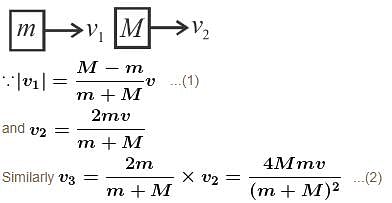

The correct answer is: 4.236
A train of mass M is moving on a circular track of radius ‘R’ with constant speed V. The length of the train is half of the perimeter of the track. The linear momentum of the train will be :- a)

- b)MVR
- c)MV
- d)0
Correct answer is option 'A'. Can you explain this answer?
A train of mass M is moving on a circular track of radius ‘R’ with constant speed V. The length of the train is half of the perimeter of the track. The linear momentum of the train will be :
a)

b)
MVR
c)
MV
d)
0
|
|
Vedika Singh answered |
If we treat the train as a ring of mass ‘M’ then its centre of mass will be at a distance
2R/π from the centre of the circle. Velocity of centre of mass is :
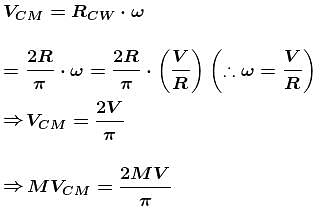
As the linear momentum of the system = MVCM
∴ The linear momentum of the train = 

The correct answer is: 

A smooth sphere A of mass m collides elastically with an identical sphere B at rest. The velocity of A before collision is 8 m/s in a direction making 60° with the line joining the centre at the time of impact. Which of the following is/are possible :- a)the sphere A comes to rest after collision
- b)the speed of B after collision is 4 m/s
- c)the sphere B will move with a speed of 8 m/s after collision
- d)the direction of motion of A and B after collision are at right angles
Correct answer is option 'B,D'. Can you explain this answer?
A smooth sphere A of mass m collides elastically with an identical sphere B at rest. The velocity of A before collision is 8 m/s in a direction making 60° with the line joining the centre at the time of impact. Which of the following is/are possible :
a)
the sphere A comes to rest after collision
b)
the speed of B after collision is 4 m/s
c)
the sphere B will move with a speed of 8 m/s after collision
d)
the direction of motion of A and B after collision are at right angles

|
Pie Academy answered |
Sphere A moving with velocity v has a component v/2 along the line joining the centres of the spheres at the time of collision and another component perpendicular to the previous direction. After collision the component along the line will interchange i.e. B will move with v/2 velocity i.e., 4 m/s along the line joining the centres and A moves with  velocity at perpendicular direction to B.
velocity at perpendicular direction to B.
 velocity at perpendicular direction to B.
velocity at perpendicular direction to B.The correct answers are: the direction of motion of A and B after collision are at right angles, the speed of B after collision is 4 m/s
A bag of mass M hangs by a long thread and a bullet (mass m) comes horizontally with velocity v and gets caught in the bag. Then for the combined system (bag + bullet) which of the following are correct- a)Momentum is mv
- b)Momentum is mMv(M + m)
- c)KE is m2v2(M + m)/2
- d)KE is Mv2/2
Correct answer is option 'A,C'. Can you explain this answer?
A bag of mass M hangs by a long thread and a bullet (mass m) comes horizontally with velocity v and gets caught in the bag. Then for the combined system (bag + bullet) which of the following are correct
a)
Momentum is mv
b)
Momentum is mMv(M + m)
c)
KE is m2v2(M + m)/2
d)
KE is Mv2/2

|
Pie Academy answered |
Since, Fext = 0
Hence, momentum will remain conserved equal to mv.
Hence, momentum will remain conserved equal to mv.

and final kinetic energy is 

The correct answers are: Momentum is mv, KE is m2v2(M + m)/2
A particle of mass 4m which is at rest explodes into three fragments. Two of the fragments each of mass m are found to move with a speed v each in mutually perpendicular directions. The minimum energy released in the process of explosion is :- a)(3/2) mv2
- b)(2/3) mv2
- c)(4/3) mv2
- d)(3/4) mv2
Correct answer is option 'A'. Can you explain this answer?
A particle of mass 4m which is at rest explodes into three fragments. Two of the fragments each of mass m are found to move with a speed v each in mutually perpendicular directions. The minimum energy released in the process of explosion is :
a)
(3/2) mv2
b)
(2/3) mv2
c)
(4/3) mv2
d)
(3/4) mv2
|
|
Vedika Singh answered |

The correct answer is: (3/2) mv2
Two particles A and B start moving due to their mutual interaction only. If any time t,  are their respective acceleration,
are their respective acceleration, are their respective velocities and upto that time WA and WB are the work done on A and B respectively by the mutual force, mA and mB are their masses respectively, then which of the following is always incorrect.
are their respective velocities and upto that time WA and WB are the work done on A and B respectively by the mutual force, mA and mB are their masses respectively, then which of the following is always incorrect.- a)

- b)

- c)

- d)

Correct answer is option 'B,C,D'. Can you explain this answer?
Two particles A and B start moving due to their mutual interaction only. If any time t,  are their respective acceleration,
are their respective acceleration, are their respective velocities and upto that time WA and WB are the work done on A and B respectively by the mutual force, mA and mB are their masses respectively, then which of the following is always incorrect.
are their respective velocities and upto that time WA and WB are the work done on A and B respectively by the mutual force, mA and mB are their masses respectively, then which of the following is always incorrect.
 are their respective acceleration,
are their respective acceleration, are their respective velocities and upto that time WA and WB are the work done on A and B respectively by the mutual force, mA and mB are their masses respectively, then which of the following is always incorrect.
are their respective velocities and upto that time WA and WB are the work done on A and B respectively by the mutual force, mA and mB are their masses respectively, then which of the following is always incorrect.a)

b)

c)

d)

|
|
Vedika Singh answered |
Since  ∴ Momentum of system will remain conserved, equal to zero.
∴ Momentum of system will remain conserved, equal to zero.
 ∴ Momentum of system will remain conserved, equal to zero.
∴ Momentum of system will remain conserved, equal to zero.The correct answers are: 

The figure shows a hollow cube of side a of volume V. There is a small chamber of volume V/4 in the cube as shown. This chamber is completely filled by m kg of water. Water leaks through a hole H. The the work done by gravity in this process assuming that the complete water finally lies at the bottom of the cube is :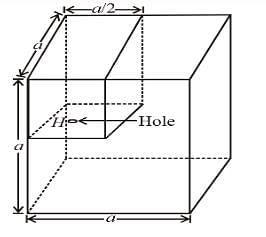
- a)

- b)

- c)

- d)

Correct answer is option 'C'. Can you explain this answer?
The figure shows a hollow cube of side a of volume V. There is a small chamber of volume V/4 in the cube as shown. This chamber is completely filled by m kg of water. Water leaks through a hole H. The the work done by gravity in this process assuming that the complete water finally lies at the bottom of the cube is :

a)

b)

c)

d)

|
|
Vedika Singh answered |
Let h be the height of water surface, finally
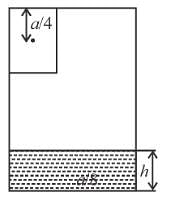

∴ C.M. gets lowered by 



Two blocks of equal mass m are connected by an unstretched spring and the system is kept at rest on a frictionless horizontal surface. A constant force F is applied on the first block pulling it away from the other as shown in figure.
- a)The displacement of the right block, if the extension of the spring is x0 at time t, is

- b)The displacement of the left block, if the extension of the spring is x0 at time t, is

- c)The displacement of the centre of mass at time t is

- d)The displacement of the centre of mass at time t is

Correct answer is option 'A,B,D'. Can you explain this answer?
Two blocks of equal mass m are connected by an unstretched spring and the system is kept at rest on a frictionless horizontal surface. A constant force F is applied on the first block pulling it away from the other as shown in figure.

a)
The displacement of the right block, if the extension of the spring is x0 at time t, is 

b)
The displacement of the left block, if the extension of the spring is x0 at time t, is 

c)
The displacement of the centre of mass at time t is 

d)
The displacement of the centre of mass at time t is 

|
|
Vedika Singh answered |
The acceleration of the centre of mass is

The displacement of the centre of mass at time t will be

Therefore initial velocity is either in direction of constant force or opposite to it. Hence the particle will move in straight line and speed may increase or decrease. When F and u are antiparallel then particle will come to rest for an instant and will return back.

Initial velocity is perpendicular to constant force, hence the path will be parabolic with speed of particle increasing.  means instantaneous velocity is always perpendicular to force. Hence the speed will remain constant. And also
means instantaneous velocity is always perpendicular to force. Hence the speed will remain constant. And also  constant. Since the particle moves in one plane, the resulting motion has to be circular.
constant. Since the particle moves in one plane, the resulting motion has to be circular.  Hence initial velocity is in same direction of constant acceleration, therefore, particle moves in straight line with increasing speed.
Hence initial velocity is in same direction of constant acceleration, therefore, particle moves in straight line with increasing speed.
 means instantaneous velocity is always perpendicular to force. Hence the speed will remain constant. And also
means instantaneous velocity is always perpendicular to force. Hence the speed will remain constant. And also  constant. Since the particle moves in one plane, the resulting motion has to be circular.
constant. Since the particle moves in one plane, the resulting motion has to be circular.  Hence initial velocity is in same direction of constant acceleration, therefore, particle moves in straight line with increasing speed.
Hence initial velocity is in same direction of constant acceleration, therefore, particle moves in straight line with increasing speed.The correct answers are: The displacement of the centre of mass at time t is  The displacement of the right block, if the extension of the spring is x0 at time t, is
The displacement of the right block, if the extension of the spring is x0 at time t, is  The displacement of the left block, if the extension of the spring is x0 at time t, is
The displacement of the left block, if the extension of the spring is x0 at time t, is 
 The displacement of the right block, if the extension of the spring is x0 at time t, is
The displacement of the right block, if the extension of the spring is x0 at time t, is  The displacement of the left block, if the extension of the spring is x0 at time t, is
The displacement of the left block, if the extension of the spring is x0 at time t, is 
A particle strikes a horizontal smooth floor with a velocity u making an angle with the floor and rebounds with velocity v making and angle  with the floor. If the coefficient of restitution between the particle and the floor is e, then :
with the floor. If the coefficient of restitution between the particle and the floor is e, then :- a)

- b)the impulse delivered by the floor to the body is mu(1 + e)θ
- c)the ratio of the final kinetic energy to the initial kinetic energy is cos2 θ + e2 sin2 θ
- d)tan
 = e tan θ
= e tan θ
Correct answer is option 'A,B,C,D'. Can you explain this answer?
A particle strikes a horizontal smooth floor with a velocity u making an angle with the floor and rebounds with velocity v making and angle  with the floor. If the coefficient of restitution between the particle and the floor is e, then :
with the floor. If the coefficient of restitution between the particle and the floor is e, then :
 with the floor. If the coefficient of restitution between the particle and the floor is e, then :
with the floor. If the coefficient of restitution between the particle and the floor is e, then :a)

b)
the impulse delivered by the floor to the body is mu(1 + e)θ
c)
the ratio of the final kinetic energy to the initial kinetic energy is cos2 θ + e2 sin2 θ
d)
tan  = e tan θ
= e tan θ
 = e tan θ
= e tan θ|
|
Vedika Singh answered |



In horizontal direction, momentum is conserved :


in vertical direction,
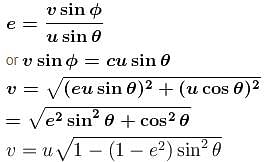
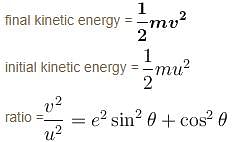
The correct answers are: the impulse delivered by the floor to the body is 
 the ratio of the final kinetic energy to the initial kinetic energy is
the ratio of the final kinetic energy to the initial kinetic energy is 

 the ratio of the final kinetic energy to the initial kinetic energy is
the ratio of the final kinetic energy to the initial kinetic energy is 
A stationary body explodes into four identical fragments such that three of them fly off mutually perpendicular to each other, each with same kinetic energy., E0. The energy of explosion is given by nE0. Find the value of n.
Correct answer is '6'. Can you explain this answer?
A stationary body explodes into four identical fragments such that three of them fly off mutually perpendicular to each other, each with same kinetic energy., E0. The energy of explosion is given by nE0. Find the value of n.
|
|
Vedika Singh answered |
Let the three mutually perpendicular direction be along x, y and z-axis respectively.

By linear momentum conservation,
 = 3E0 + 3E0
= 3E0 + 3E0= 6E0
The correct answer is: 6
A bullet of mass a and velocity b is fired into a large block of mass c. The final velocity of the system is :- a)

- b)

- c)

- d)

Correct answer is option 'D'. Can you explain this answer?
A bullet of mass a and velocity b is fired into a large block of mass c. The final velocity of the system is :
a)

b)

c)

d)


|
Pie Academy answered |
From momentum conservation Pi = Pf
ab = (a + c)v
ab = (a + c)v

The correct answer is: 

Three particles of mass 20gm, 30gm and 40gm are initially moving along the positive direction of the three coordinate axes respectively with the same velocity of 20 cm/s. If due to their mutual interaction, the first particle comes to rest, the second acquires a velocity  What is the magnitude of velocity (in cm/s) of the third particle?
What is the magnitude of velocity (in cm/s) of the third particle?
Correct answer is '16.007'. Can you explain this answer?
Three particles of mass 20gm, 30gm and 40gm are initially moving along the positive direction of the three coordinate axes respectively with the same velocity of 20 cm/s. If due to their mutual interaction, the first particle comes to rest, the second acquires a velocity  What is the magnitude of velocity (in cm/s) of the third particle?
What is the magnitude of velocity (in cm/s) of the third particle?
 What is the magnitude of velocity (in cm/s) of the third particle?
What is the magnitude of velocity (in cm/s) of the third particle?

|
Pie Academy answered |


The correct answer is: 16.007
A man of mass M hanging with a light rope which is connected with a balloon of mass m. The system is at rest in air. When man rises a distance h with respect to balloon. Find the distance raised by man :- a)

- b)

- c)

- d)

Correct answer is option 'A'. Can you explain this answer?
A man of mass M hanging with a light rope which is connected with a balloon of mass m. The system is at rest in air. When man rises a distance h with respect to balloon. Find the distance raised by man :
a)

b)

c)

d)

|
|
Jayant Mishra answered |
Initially 

since no external force is acting
∴ COM should be at rest


Let balloon descend by a distance x.

Mh = (m + M)x
 (Distance descend by balloon)
(Distance descend by balloon) (Distance raised by man)
(Distance raised by man)The correct answer is: 

Two masses of 1gm and 4gm are moving with equal kinetic energy. Find the Ratio of the magnitude of their linear momentum :
Correct answer is '1/2'. Can you explain this answer?
Two masses of 1gm and 4gm are moving with equal kinetic energy. Find the Ratio of the magnitude of their linear momentum :
|
|
Jayant Mishra answered |
KE= 1/2 m*v^2
Momentum (p)=m*v
Set each of the 1 gram and 4 grams KE to 8:
KE=1/2 *1* (4)^2=8
KE=1/2 *4* (2)^2=8
The 1 gram takes 4 m/s to achieve KE of 8.
The 4 gram takes 2 m/s to achieve KE of 8.
Therefore, the ratio of their linear momentum (m*v) is:
1*4/4*2= 4/8= 1/2
A system of the blocks A and B are connected by an inextensible massless string as shown in the figure. The pulley is massless and frictionless. Initially the system is at rest when, a bullet of mass m moving with a velocity u hits the block B and gets embedded into it. The impulse imparted by tension force to the block of mass 3m is :
- a)3mu/5
- b)2mu/5
- c)4mu/5
- d)5mu/4
Correct answer is option 'A'. Can you explain this answer?
A system of the blocks A and B are connected by an inextensible massless string as shown in the figure. The pulley is massless and frictionless. Initially the system is at rest when, a bullet of mass m moving with a velocity u hits the block B and gets embedded into it. The impulse imparted by tension force to the block of mass 3m is :

a)
3mu/5
b)
2mu/5
c)
4mu/5
d)
5mu/4
|
|
Jayant Mishra answered |
By conservation of linear momentum along the string.
mu = (m + m + 3m)v
or v = u/5
mu = (m + m + 3m)v
or v = u/5
and impulse on the block 

The correct answer is: 

Three ball A, B and C (mA = mC = 4 mB) are placed on a smooth horizontal surface. Ball B collides with ball C with an initial velocity v as shown in the figure. Total number of collision between the balls will be : (All collisions are elastic)
Correct answer is '2'. Can you explain this answer?
Three ball A, B and C (mA = mC = 4 mB) are placed on a smooth horizontal surface. Ball B collides with ball C with an initial velocity v as shown in the figure. Total number of collision between the balls will be : (All collisions are elastic)


|
Pie Academy answered |
For 1st collision
Since
Since

e = 1
v = v1 + v2
⇒ v2 = v – v1 ...(1)
By momentum conservation :


For second collision :


By momentum conservation :

From (2) and (4) :

Therefore B can not collide with C for the second time.
Hence; total number of collision is 2.
The correct answer is: 2
Hence; total number of collision is 2.
The correct answer is: 2
A particle of mass m is moving along the x-axis with speed v when it collides with a particle of mass 2m initially at rest. After the collision, the first particle has come to rest and the second particle has split into two equal-mass pieces that are shown in the figure. Which of the following statements correctly describes the speeds of the two pieces? (θ > 0)
- a)Each piece moves with speed v/2.
- b)Each piece moves with speed greater than v/2.
- c)One of the pieces moves with speed v/2, the other moves with speed greater than v/2
- d)Each piece moves with speed v
Correct answer is option 'B'. Can you explain this answer?
A particle of mass m is moving along the x-axis with speed v when it collides with a particle of mass 2m initially at rest. After the collision, the first particle has come to rest and the second particle has split into two equal-mass pieces that are shown in the figure. Which of the following statements correctly describes the speeds of the two pieces? (θ > 0)

a)
Each piece moves with speed v/2.
b)
Each piece moves with speed greater than v/2.
c)
One of the pieces moves with speed v/2, the other moves with speed greater than v/2
d)
Each piece moves with speed v

|
Anagha Chauhan answered |
After collision by momentum conservation :
Along y-axis

Along x-axis

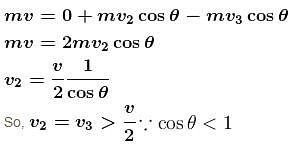
The correct answer is: Each piece moves with speed greater than v/2.
Chapter doubts & questions for Centre of Mass & Moment of Inertia - Mechanics & General Properties of Matter 2024 is part of Physics exam preparation. The chapters have been prepared according to the Physics exam syllabus. The Chapter doubts & questions, notes, tests & MCQs are made for Physics 2024 Exam. Find important definitions, questions, notes, meanings, examples, exercises, MCQs and online tests here.
Chapter doubts & questions of Centre of Mass & Moment of Inertia - Mechanics & General Properties of Matter in English & Hindi are available as part of Physics exam.
Download more important topics, notes, lectures and mock test series for Physics Exam by signing up for free.
Mechanics & General Properties of Matter
61 videos|23 docs|25 tests
|
Signup to see your scores go up within 7 days!
Study with 1000+ FREE Docs, Videos & Tests
10M+ students study on EduRev
|
Free Exam Preparation
at your Fingertips!
Access Free Study Material - Test Series, Structured Courses, Free Videos & Study Notes and Prepare for Your Exam With Ease

 Join the 10M+ students on EduRev
Join the 10M+ students on EduRev
|

|
Forgot Password
OR
Signup to see your scores
go up within 7 days!
Access 1000+ FREE Docs, Videos and Tests
Takes less than 10 seconds to signup
